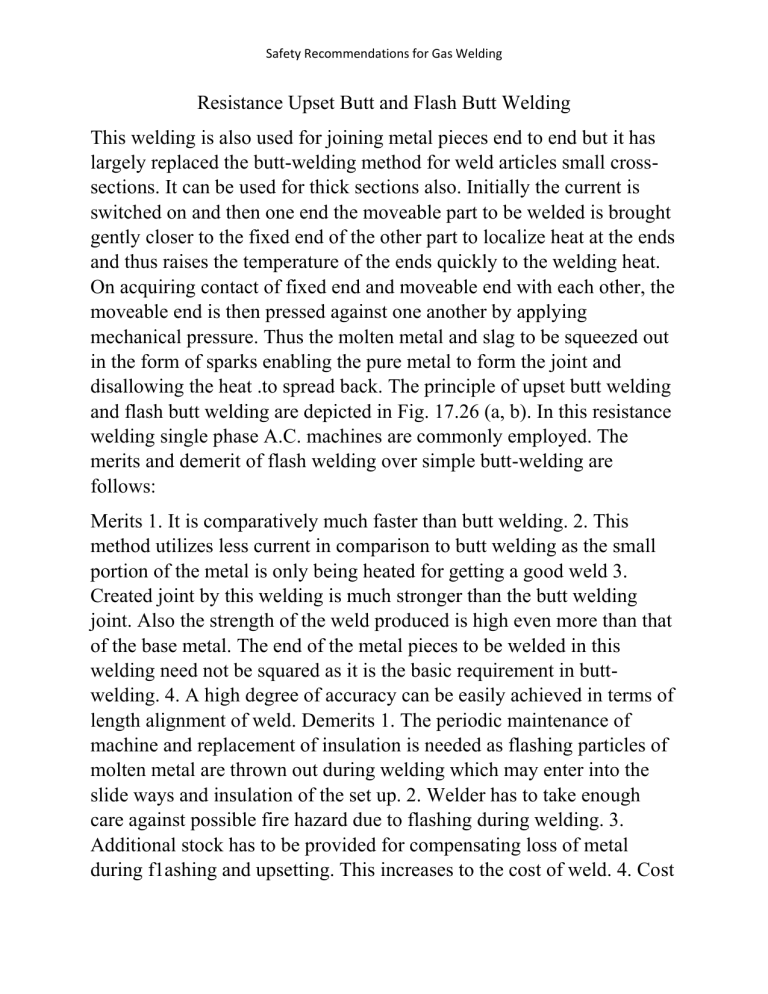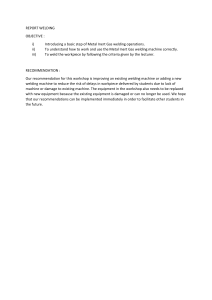
Safety Recommendations for Gas Welding Resistance Upset Butt and Flash Butt Welding This welding is also used for joining metal pieces end to end but it has largely replaced the butt-welding method for weld articles small crosssections. It can be used for thick sections also. Initially the current is switched on and then one end the moveable part to be welded is brought gently closer to the fixed end of the other part to localize heat at the ends and thus raises the temperature of the ends quickly to the welding heat. On acquiring contact of fixed end and moveable end with each other, the moveable end is then pressed against one another by applying mechanical pressure. Thus the molten metal and slag to be squeezed out in the form of sparks enabling the pure metal to form the joint and disallowing the heat .to spread back. The principle of upset butt welding and flash butt welding are depicted in Fig. 17.26 (a, b). In this resistance welding single phase A.C. machines are commonly employed. The merits and demerit of flash welding over simple butt-welding are follows: Merits 1. It is comparatively much faster than butt welding. 2. This method utilizes less current in comparison to butt welding as the small portion of the metal is only being heated for getting a good weld 3. Created joint by this welding is much stronger than the butt welding joint. Also the strength of the weld produced is high even more than that of the base metal. The end of the metal pieces to be welded in this welding need not be squared as it is the basic requirement in buttwelding. 4. A high degree of accuracy can be easily achieved in terms of length alignment of weld. Demerits 1. The periodic maintenance of machine and replacement of insulation is needed as flashing particles of molten metal are thrown out during welding which may enter into the slide ways and insulation of the set up. 2. Welder has to take enough care against possible fire hazard due to flashing during welding. 3. Additional stock has to be provided for compensating loss of metal during f1ashing and upsetting. This increases to the cost of weld. 4. Cost Safety Recommendations for Gas Welding of removal of flash weld metal by trimming, chipping, grinding, etc. will increase to the welded product. Welding and cutting of metals involve the application of intense heat to the objects being welded or cut. This intense heat in welding is obtained from the use of inflammable gases, (e.g. acetylene, hydrogen, etc.) or electricity. The intense welding heat and the sources employed to produce it can be potentially hazardous. Therefore, to protect persons from injury and to protect building and equipment against fire, etc., a set of recommendations concerning safety and health measures for the welders and those concerned with the safety of the equipments etc., have been published by BIS and many other similar but International organizations. By keeping in mind these recommendations or precautions, the risks associated with welding can be largely reduced. Therefore, it is suggested that the beginner in the field of gas welding must go through and become familiar with these general safety recommendations, which are given below. 1. Never hang a torch with its hose on regulators or cylinder valves. 2. During working, if the welding tip becomes overheated it may be cooled by plunging the torch into water; close the acetylene valve but leave a little oxygen flowing. 3. Always use the correct pressure regulators for a gas. Acetylene pressure regulator should never be used with any other gas. 4. Do not move the cylinder by holding the pressure regulator and also handle pressure regulators carefully. 5. Use pressure regulator only at pressures for which it is intended. 6. Open cylinder valves slowly to avoid straining the mechanism of pressure regulator. 7. Never use oil, grease or lubricant of any kind on regulator connections. For repairs, calibrations and adjustments purposes, the pressure regulators should be sent to the supplier. 9. Do cracking before connecting pressure regulator to the gas cylinder. 10. Inspect union nuts and connections on regulators before use to detect faulty seats which may cause leakage of gas when the regulators are attached to the Safety Recommendations for Gas Welding cylinder valves. 11. Hose connections shall be well fittings and clamped properly otherwise securely fastened to these connections in such a manner as to withstand without leakage a pressure twice as great as the maximum delivery pressure of the pressure regulators provided on the system. 12. Protect the hose from flying sparks, hot slag, hot workpiece and open flame. If dirt goes into hose, blow through (with oxygen, not acetylene) before coupling to torch or regulator. 13. Store hose on a reel (an automobile wheel) when not in use. 14. Never allow the hose to come into contact with oil or grease; these deteriorate the rubber and constitute a hazard with oxygen. 15. Use the correct color hose for oxygen (green/black) and acetylene (red) and never use oxygen hose for acetylene or vice versa. 16. Always protect hose from being trampled on or run over. Avoid tangle and kinks. Never leave the hose so that it can be tripped over. Hazards of fumes, gases and dusts can be minimized by (i) improving general ventilation of the place where welding is carried out (ii) using local exhaust units, and (iii) wearing individual respiratory protective equipment. ARC WELDING PROCESSES The process, in which an electric arc between an electrode and a workpiece or between two electrodes is utilized to weld base metals, is called an arc welding process. The basic principle of arc welding is shown in Fig 17.9(a). However the basic elements involved in arc welding process are shown in Fig. 17.9(b). Most of these processes use some shielding gas while others employ coatings or fluxes to prevent the weld pool from the surrounding atmosphere. The various arc welding processes are: 1. Carbon Arc Welding 2. Shielded Metal Arc Welding 3. Flux Cored Arc Welding 4. Gas Tungsten Arc Welding 5. Gas Metal Safety Recommendations for Gas Welding Arc Welding 6. Plasma Arc Welding 7. Atomic Hydrogen Welding 8. Electroslag Welding



